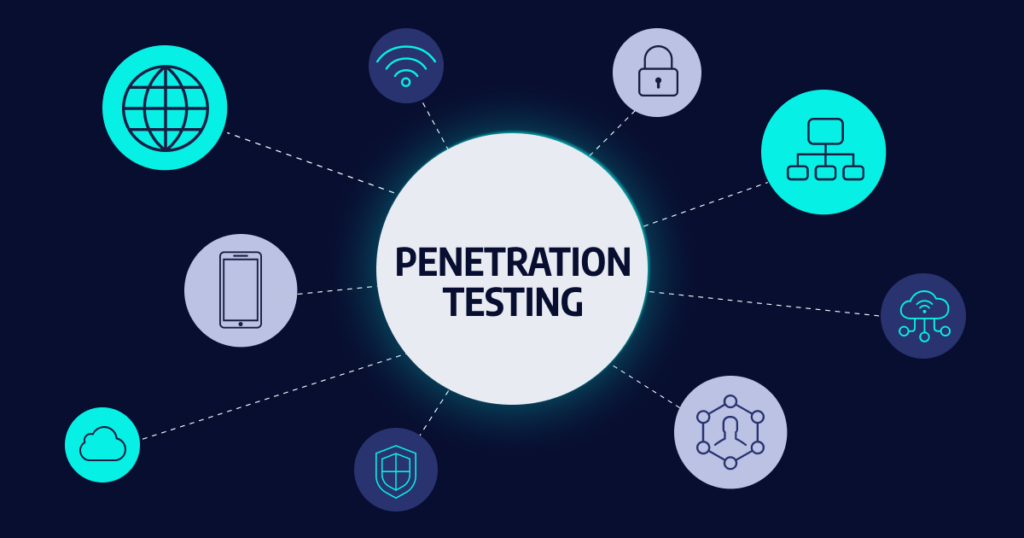
Penetration Testing: Overview and Step-by-Step Process
Penetration testing, also known as “ethical hacking,” is the practice of testing a computer system, network, or web application to identify vulnerabilities that an attacker could exploit. It simulates real-world cyberattacks to assess the effectiveness of an organization’s security defenses.
Step 1: Planning and Preparation
- Define Scope:
- Assets to Test: Clearly define the systems, applications, or network segments that will be tested. This can include specific servers, databases, web applications, or devices.
- Testing Boundaries: Identify what is in-scope and out-of-scope (e.g., network devices, external infrastructure, or sensitive areas like production systems).
- Testing Goals: Set clear objectives for the penetration test (e.g., identifying vulnerabilities, demonstrating the impact of exploitation, testing incident response processes).
- Get Authorization:
- Obtain written permission from the organization’s stakeholders to perform the penetration test. This ensures legal protection and compliance.
- Define acceptable testing methods (e.g., social engineering, denial-of-service) and obtain consent for aggressive techniques like brute-forcing or exploiting zero-day vulnerabilities.
- Create a Test Plan:
- Develop a plan that includes the timeline, tools, and methodologies that will be used. It should also outline the roles and responsibilities of both testers and stakeholders.
Step 2: Information Gathering (Reconnaissance)
- Passive Reconnaissance:
- Publicly Available Information: Gather information about the target from publicly available sources like websites, DNS records, WHOIS data, social media, and past security incidents.
- Tools: Google dorking, WHOIS lookups, DNS reconnaissance tools (e.g., NSLookup, dig), and social media search.
- Active Reconnaissance:
- Network Scanning: Identify live hosts, open ports, and services running on the target network.
- Scanning: Use tools like Nmap, Masscan, or Nessus to perform port scans and service enumeration.
- Banner Grabbing: Obtain details about the software versions, operating systems, and services running on the target systems. Tools include Netcat or Telnet for banner grabbing.
Step 3: Threat Modeling and Vulnerability Identification
- Identify Entry Points:
- Based on the reconnaissance, determine the potential points of entry (e.g., open ports, exposed services, public-facing applications).
- Vulnerability Scanning:
- Use automated vulnerability scanners (e.g., OpenVAS, Nessus, Nexpose) to detect known vulnerabilities in the identified services or systems.
- Manually check for vulnerabilities that might not be detected by automated tools, such as business logic flaws in applications or misconfigurations.
- Manual Exploration:
- Explore more complex vulnerabilities that automated tools may not identify, such as SQL injection, cross-site scripting (XSS), file inclusion vulnerabilities, or privilege escalation issues.
Step 4: Exploitation
- Exploit Vulnerabilities:
- Attempt to exploit identified vulnerabilities to gain unauthorized access to systems, escalate privileges, or execute arbitrary commands.
- Tools: Metasploit, custom exploit scripts, or publicly available exploits.
- Privilege Escalation:
- Once inside the system, try to escalate your privileges (e.g., gain root or admin access) to further compromise the system and explore deeper layers of the network.
- Techniques: Exploiting weak configurations, vulnerable software versions, or improper user permissions.
- Post-Exploitation:
- Gather information about the compromised systems (e.g., user credentials, network topology, sensitive data).
- Maintain persistence (create backdoors or tokens) to simulate an ongoing threat actor’s access.
Step 5: Post-Exploitation and Reporting
- Data Collection and Evidence:
- Collect data that shows how vulnerabilities can be exploited. This could include screenshots, logs, or any data that demonstrates access or compromise.
- If necessary, capture sensitive information (e.g., passwords, tokens) to simulate the real impact of the exploitation.
- Reporting:
- Executive Summary: Provide high-level details for non-technical stakeholders, including key findings, severity of vulnerabilities, and risk assessment.
- Detailed Findings: Include detailed descriptions of the vulnerabilities discovered, how they were exploited, and the impact on the system or organization.
- Risk Assessment: Categorize vulnerabilities by risk (e.g., critical, high, medium, low) based on potential impact and likelihood of exploitation.
- Recommendations: Provide actionable remediation steps for each vulnerability (e.g., applying patches, configuring firewalls, enforcing stronger authentication).
- Proof of Concept (PoC): Include PoC code or screenshots of successful exploitation for technical teams to understand the vulnerability and remediation.
Step 6: Remediation and Verification
- Assist with Remediation:
- Work with the organization’s IT and security teams to help them address the vulnerabilities found during the penetration test.
- This could involve patching systems, hardening configurations, or updating software.
- Re-test (Optional):
- After remediation, re-test the system to verify that the vulnerabilities have been properly addressed and that no new vulnerabilities were introduced.
- Continuous Monitoring and Improvement:
- Suggest the implementation of continuous monitoring solutions (e.g., SIEM, intrusion detection/prevention systems) to catch potential attacks in the future.
- Encourage regular penetration testing and security audits to keep defenses up-to-date.
Types of Penetration Tests:
- Black Box Testing: The tester has no prior knowledge of the system or network. They perform testing purely based on publicly available information.
- White Box Testing: The tester has full knowledge of the system, including source code, network diagrams, and configurations. This method is used for a more in-depth security assessment.
- Gray Box Testing: The tester has partial knowledge, typically in the form of access to some internal documentation or accounts, simulating the perspective of an insider with limited access.
Tools Commonly Used in Penetration Testing:
- Reconnaissance Tools:
- Nmap, Netcat, WHOIS, dig, Maltego, Shodan
- Vulnerability Scanners:
- Nessus, OpenVAS, Nexpose, Qualys
- Exploitation Frameworks:
- Metasploit, BeEF (Browser Exploitation Framework), Social-Engineer Toolkit (SET)
- Password Cracking:
- John the Ripper, Hashcat
- Web Application Testing:
- Burp Suite, OWASP ZAP, Nikto, Acunetix
- Privilege Escalation:
- LinPEAS, Windows Exploit Suggester, PowerUp
- Post-Exploitation Tools:
- Empire, Cobalt Strike
Conclusion:
Penetration testing is a proactive security measure that helps organizations identify and mitigate vulnerabilities before attackers can exploit them. By following a systematic approach to reconnaissance, vulnerability identification, exploitation, and reporting, penetration testers can help improve an organization’s security posture and reduce its attack surface. Regular penetration tests are essential to stay ahead of emerging threats and vulnerabilities in an ever-evolving security landscape.